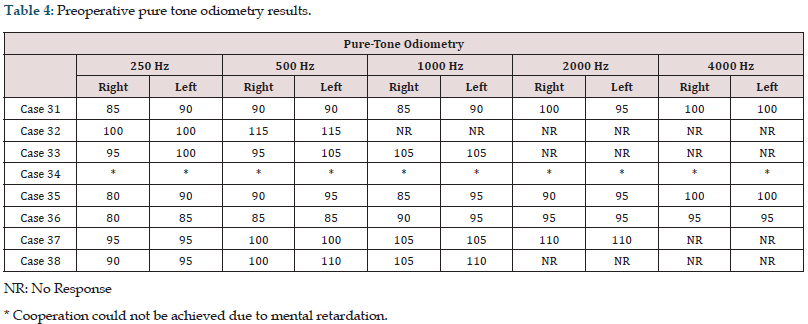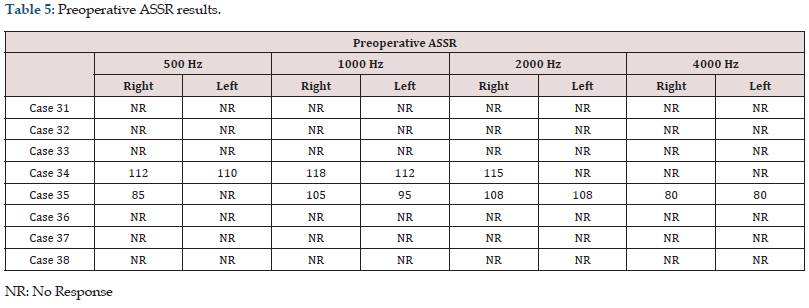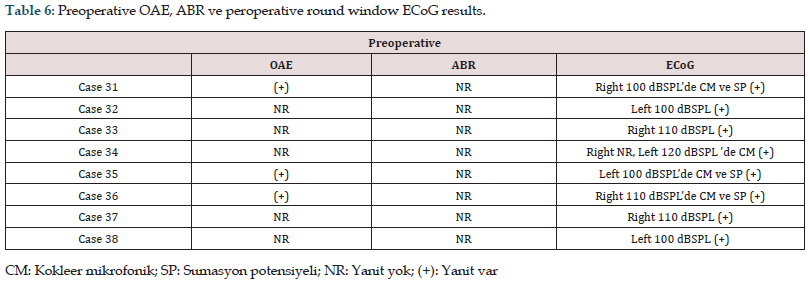
Lupine Publishers Group
Lupine Publishers
Menu
ISSN: 2641-1709
Case Report(ISSN: 2641-1709) 
Round Window Electrochleography in Cochlear Implantation Volume 5 - Issue 5
Asil Ergin1*, Mehmet Ziya Özüer2 and Levent Olgun3
- 1ENT Department, Ödemiş State Hospital, Turkey
- 2ENT Department, Acıbadem University Bodrum Hospital, Turkey
- 3ENT Department, Başkent University Zübeyde Hanım Hospital, Turkey
Received: January 11, 2021 Published: January 27, 2021
Corresponding author: Asil Ergin, ENT Department, Ödemiş State Hospital, İzmir, Turkey
DOI: 10.32474/SJO.2021.05.000223
Abstract
Introduction: In this study which was achieved at Izmir Bozyaka Teaching and Research Hospital, identifying the sensitivity and reliability of round window electrocochleographic records on children during cochlear implantation and investigating the applicability of the method on particularly problematic patient groups was aimed.
Material and Methods: In this study, the golf-club electrode was placed on the round window niche during cochlear implantation of 30 patients after posterior tympanotomy. Then click stimulus was given by TDH 39 headphones over the speculum which was placed in the external ear canal and the responses that obtained from the stimuli were recorded with Medelec Snergy Amplifier device. The round window ECoG records which were obtained from these 30 patients were compared with the preoperative ABR results. Round window ECoG responses were acquired during operation in 22 patients who had no response to ABR preoperatively. Two patients responded to both preoperative ABR and perioperative round window ECoG. And 7 patients had no preoperative ABR and perioperative round window ECoG responses.
Discussion: Our outcome data shows that round window ECoG is more sensitive than ABR while deciding for cochlear implantation. The results are statistically significant. Outside of the study, there were 8 patients more. These 8 patients had some abnormalities and because of these abnormalities it was difficult for us to decide for cochlear implantation. We performed round window ECoG to these 8 patients via trans canal way. In these patients we again found that round window ECoG is more sensitive than ABR for determination of residual hearing and it can be a guiding test for us to decide for cochlear implantation in patients with abnormalities.
Conclusion: As a result, round window ECoG is a very sensitive method for determination of residual hearing and it might be used in patients who has abnormalities such as bony labyrinth abnormalities, auditory neuropathy, and meatus acousticus internus stenosis that complicates our decision for cochlear implantation.
Keywords:Cochlear implantation; round window electrocochleography; auditory brainstem response (ABR)
Introduction
Standard audiological examinations are often insufficient in detecting pediatric hearing losses and directing them to rehabilitation with the correct method by determining the degree of hearing loss, and modern electrophysiological test batteries should be used. Among these tests, various otoacoustic emission measurement methods, immitansmetry and stapes reflex measurements, brainstem audiometry, auditory steady state response audiometry and electrocochleography are valuable methods, and most of the time, several of these tests must be combined to reach a diagnosis. Patients with auditory neuropathy constitute another group whose audiological evaluation is very difficult. In these patients, rehabilitation with the correct method can sometimes lead to serious time losses due to the exact localization of the lesion. Recently, electrocochleography has begun to gain popularity as a fast, effective, and safe method, especially in patients with difficulty in diagnosis and referral to rehabilitation, such as bone labyrinth anomaly and auditory neuropathy [1]. It is reported that the application of the electrode to the round window will produce much better results in terms of accurate recording. In this study, it was aimed to investigate the applicability of this method, especially in problematic patient groups, by determining the sensitivity and reliability of electrocochleographic recordings to be taken with a golf-club electrode applied to a round window in pediatric patients with cochlear implantation.
Material and Methods
This study was carried out on 30 patients who underwent cochlear implantation surgery in Izmir Bozyaka Training and Research Hospital Ear Nose Throat Clinic and Cochleer Implant Center. The patients enrolled in the study were randomly selected from the patients who were referred to a cochlear implant center due to hearing loss and whose suitability for the cochlear implant was investigated. Informed consent forms were obtained from the parents or legal guardians of all patients for the study. All patients were routinely examined with temporal bone CT and contrast-enhanced temporal bone MRI before surgery. Subjective audiological tests compatible with their age and a test battery consisting of tympanometry, ABR, DPOAE and ASSR were applied to all patients. In these tests, GSI Audera, 2 channel amplifier was used. Apart from this study group, two patients with meatus acousticus internus stenosis, one patient with auditory neuropathy and one patient operated for a benign mass in the brainstem were examined by round window electrocochleography. All patients in the study group underwent surgery for cochlear implantation, and after the posterior tympanotomy stage of this surgery, it was planned to take electrocochleographic recording using a specially made electrode that directly touches the round window membrane after the round window became visible.
In all patients, after general anesthesia, the postauricular area, external ear canal and vertex and auricular lobule, where needle electrodes will be placed, were field cleaned with povidone-iodine (Betadine®) and two needle electrodes were placed in the vertex and the reference electrode was placed in the auricular lobule in the ear to be tested. A special hand-made golf-club electrode was used for the round window niche for electrocochleographic recording (Figure 1). First, limited mastoidectomy and posterior tympanotomy were performed in all patients for cochlear implantation. Following the posterior tympanotomy, the golf-club electrode connected to the Medelec Snergy (5 channel) amplifier device was placed in the round window niche before the round window niche was turned. Then, using the test battery in picture 30, double trace was applied with TDH 39 headphones at a repetition rate of 15 pps, starting at 130 dBnHL, a click stimulus with a duration of 130 dBnHL up to the lowest intensity that could be responded, and electrocochleographic responses were recorded. In patients outside of the study group who had difficulty in deciding, round window electrocochleography was performed under general anesthesia under general anesthesia before the cochlear implantation.
Figure 1: Tumor during microlaryngoscopy. Above the laser beam is the free edge of the epiglottis.
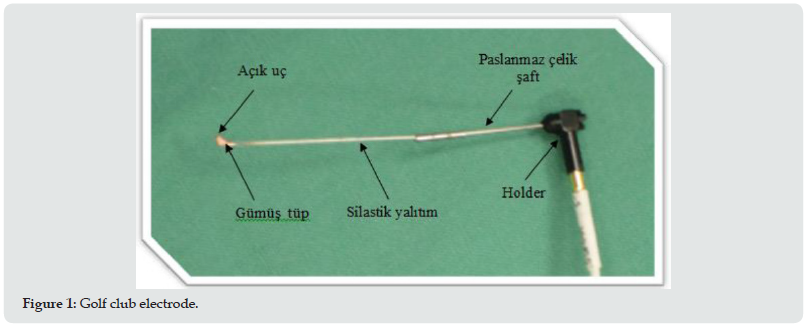
Results
Preoperative pure-tone audiometry results of 30 cochlear implantation patients included in the study are shown in Table 1, and preoperative ASSR, OAE, ABR and peroperative round window ECoG results are shown in Table 2. Statistical comparison of preoperative ABR records of 30 patients and intraoperative round window ECoG records is given in Table 3. Three patients with auditory neuropathy (cases 31,35,36), 4 patients with internal acoustic canal stenosis (cases 32,33,37,38) and a patient who underwent benign mass excision from the brain stem (Case 34) preoperative pure-tone audiometry results are shown in Table 4, preoperative ASSR results in Table 5, and preoperative OAE, ABR, and peroperative round window ECoG results are shown in Table 6.
Table 1: Preoperative pure-tone audiometry results (dB) of patients who underwent cochlear implantation.
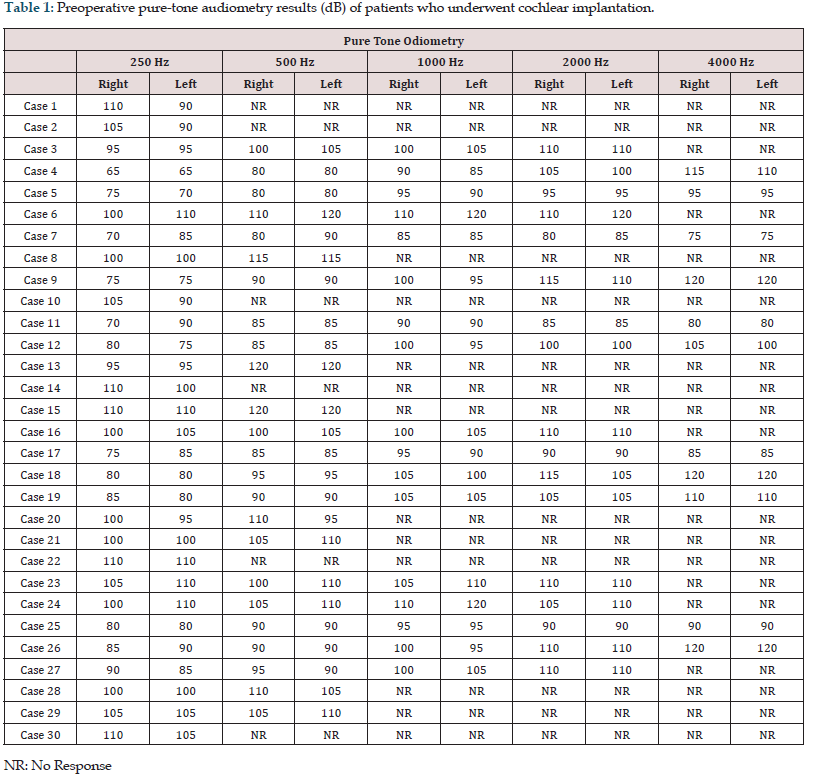
Table 2: Preoperative ASSR, OAE, ABR and peroperative round window ECoG results of patients who underwent cochlear implantation.
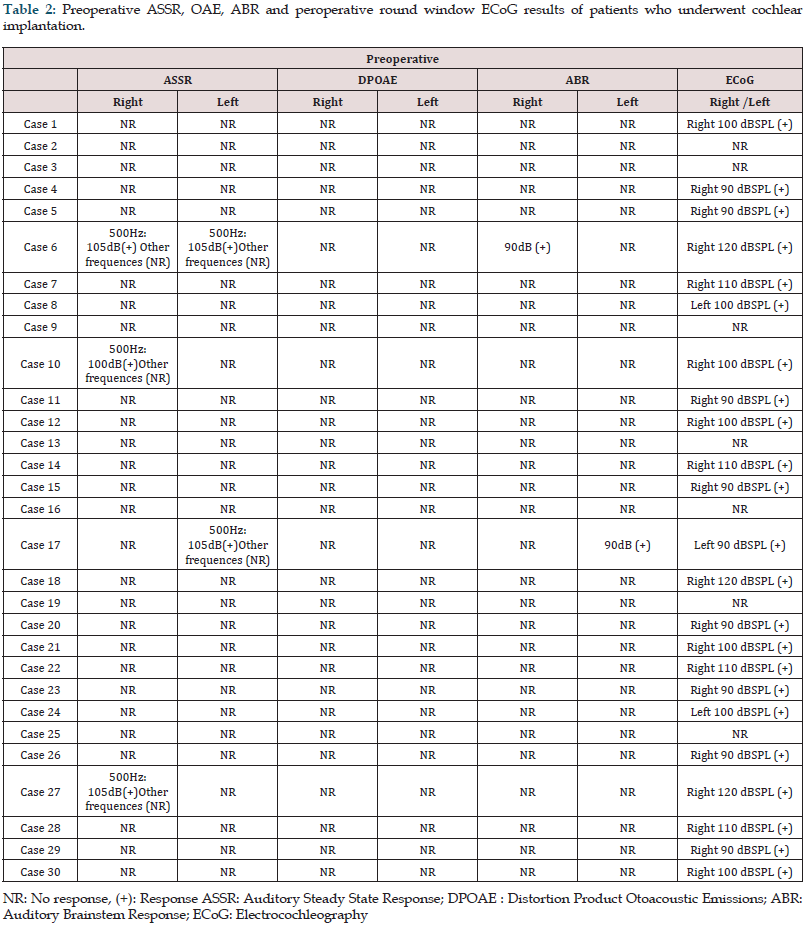
Table 3: Chi-Square test results (A computed only for a 2x2 table b 0 cells (.0%) have expected count less than 5. The minimum expected count is 12.50.)

Discussion
Although electrocochleographic recording using the trans tympanic electrode was initially seen as a breakthrough in the diagnosis of pediatric hearing loss, it has lost its popularity due to the fact that it has been seen as an invasive method by audiologists, and it seems to be confined in a limited area to diagnose Meniere’s disease. The sensitivity of electrocochleographic recording from the external auditory canal is relatively low due to the disadvantage of being away from the target organ. In this study, we aimed to investigate to what extent the records to be taken by applying the defined electrode to the round window coincide with the tests in the test battery routinely applied in pediatric hearing losses, and to examine whether this test will later be valuable in making a definitive diagnosis and / or predicting implant success in problematic cases. Since the application to the round window is a relatively invasive method, we planned to record patients who were operated for cochlear implantation. After the round window niche was exposed by performing a posterior tympanotomy during the operation, the electrode was passed through the posterior tympanotomy and the recording was made by contacting the round window membrane. Initially, it was observed that no meaningful response was obtained when recording from the operating field was requested. Thereupon, a speculum was placed in the external auditory canal and recording was made with the sound stimulus sent from the canal.
In 23 of 30 patients, a response was obtained at 110-130 dB by round window electrocochleography, and in 7 patients no response was obtained by electrocochleography. When we look at the characteristics of the patients with responses, it was observed that there was no response in the ABR in 21 patients, and the response was obtained with a stimulus of 90 dB in the ABR in two patients. One of these two patients was responded with ECoG at 90 dB and the other at 120 dB. This situation supports the idea that electrocochleography is more sensitive than ABR applications in showing the electrical activity in the cochlea against auditory stimulus. The statistical analysis results also support this view, and in the comparison of the two methods, it is revealed that the round window ECoG records are significantly different (p <0.05) compared to the ABR records, which proves that the round window ECoG is more sensitive than the ABR in determining hearing loss. It was decided to perform a round window ECoG in 8 patients who had difficulty in deciding about cochlear implant. Of the 8 patients, 3 had auditory neuropathy, 4 had acoustic canal stenosis, and one had a history of excision of the brainstem mass. In these cases, a transcanal entry was performed, the tympanomeatal flap was removed, and the round window was exposed and recorded. In all 3 neuropathy cases we performed round window electrocochleography in the preoperative period, the response with ECoG enabled us to decide on surgery in these cases. It was concluded that the presence of the ECoG response indicates that the auditory neuropathy is not due to a lesion at the cochlear nerve or higher, but to a lesion at the synapse level. This is an indication that electrical stimulation can be transmitted to the acoustic nerve after surgery. The studies of William Gibson et al. [2] also state that in cases with auditory neuropathy, getting a response in round window electrocochleography is an indicator of the benefit to be obtained from the implant. Intraoperative eABR recordings in all cases showed that 5th wave can be obtained at the level of the brainstem, which made us more hopeful in terms of the prognosis of the patients. Cochlear implantation is controversial in cases where the meatus acousticus internus is narrow and the presence of the cochlear branch of the cochleovestibular nerve cannot be clearly demonstrated by MRI, and some authors suggest direct brainstem implantation [3], while some authors suggest that there may be fibers in the nerve that connect to the acoustic sensorial organ [4].
In such cases, showing that the cochlea can be stimulated by round window electrocochleography may be a guide to the benefit of cochlear implantation. Although preoperative round window electrical ABR is also recommended in these cases [5], since we do not have this possibility, it is necessary to rely on round window ECoG recordings. In our clinic, in 4 cases with meatus acousticus internus stenosis in addition to bone labyrinth anomaly, a response was obtained in the round window ECoG performed with the technique described above, and 3 of these cases were implanted and responded with intraoperative eABR over the implant. In another pediatric patient who had previously been operated in the neurosurgery service due to a mass in the brainstem, round window electrocochleography was performed using a similar method, and implantation was not performed because only cochlear microphotography was taken but no action potential was obtained. As a result, although round window electrocochleography seems to be a relatively invasive method, it appears to be a very sensitive method in determining residual hearing. In some centers, it is recommended to be applied routinely and especially in combination with radiological examinations in the same anesthesia session. However, in our clinic, it is considered to be a reliable method in patients who have difficulty in making decisions, especially in cases of bony labyrinth anomalies, auditory neuropathy, and meatus acousticus internus stenosis.
References
- Aso S, Gibson WP (1994) Electrocochleography in profoundly deaf children: comparison of promontory and round window techniques. Am J Otol 15: 376-379.
- Sanli H, Gibson WP (2007) Auditory Neuropathy: An Update. Ear & Hearing 28: 102–106.
- Aage R Møller (2006) History of Cochlear Implants and Auditory Brainstem Implants. Adv Otorhinolaryngol. Basel, Karger 64: 1–10.
- Kabatova Z, Profant M, Simkova L, Groma M, Nechojdomova D (2009) Cochlear implantation in malformed inner ear. Bratisl Lek Listy 110: 609-613.
- Nikolopoulos TP, Mason SM, Gibbin KP, O'Donoghue GM (2000) The prognostic value of promontory electric auditory brain stem response in pediatric cochlear implantation. Ear Hear 21(3): 236-241.

Top Editors
-

Mark E Smith
Bio chemistry
University of Texas Medical Branch, USA -

Lawrence A Presley
Department of Criminal Justice
Liberty University, USA -

Thomas W Miller
Department of Psychiatry
University of Kentucky, USA -

Gjumrakch Aliev
Department of Medicine
Gally International Biomedical Research & Consulting LLC, USA -

Christopher Bryant
Department of Urbanisation and Agricultural
Montreal university, USA -

Robert William Frare
Oral & Maxillofacial Pathology
New York University, USA -

Rudolph Modesto Navari
Gastroenterology and Hepatology
University of Alabama, UK -

Andrew Hague
Department of Medicine
Universities of Bradford, UK -

George Gregory Buttigieg
Maltese College of Obstetrics and Gynaecology, Europe -

Chen-Hsiung Yeh
Oncology
Circulogene Theranostics, England -
.png)
Emilio Bucio-Carrillo
Radiation Chemistry
National University of Mexico, USA -
.jpg)
Casey J Grenier
Analytical Chemistry
Wentworth Institute of Technology, USA -
Hany Atalah
Minimally Invasive Surgery
Mercer University school of Medicine, USA -

Abu-Hussein Muhamad
Pediatric Dentistry
University of Athens , Greece

The annual scholar awards from Lupine Publishers honor a selected number Read More...




